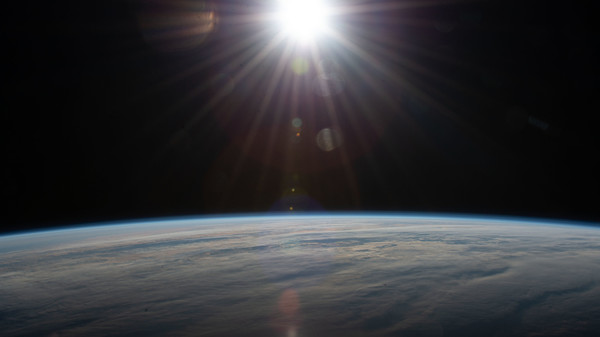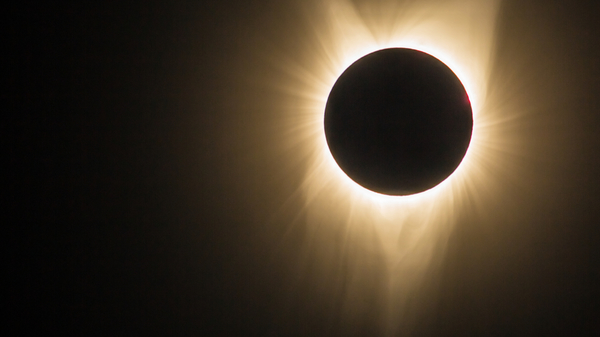The Sun: Our Home Star
The Sun converts hydrogen into helium plus huge amounts of energy in a process called nuclear fusion.

Small, dark sunspots can be seen in this image of the Sun’s disk.
©iStockphoto.com/claudiodivizia
Solar maximum 2025: A colorful aurora year
A Brief Overview of the Sun
The Sun is a star at the center of our solar system. In its core, it converts hydrogen into helium. This is done in a series of nuclear fusion reactions that produce large amounts of energy. This energy reaches Earth in the form of solar radiation (sunlight).
Stars are usually classified by their surface temperature, which also gives a rough indication of the star’s color. From hot to cool—and from blue to red—the seven main spectral classes are O, B, A, F, G, K, and M.
Our Sun is a G-type star. Its color is white, although it tends to appear yellow or red when seen through the filter of Earth’s atmosphere.
G-type stars spend about 10 billion years converting hydrogen to helium. Astronomers call this the main-sequence stage of a star’s life. Our Sun is around 4.6 billion years old, and therefore about halfway along the main sequence.
Compare the sizes and order of the Sun and the planets
Where Is the Sun in the Sky?
Find sunrise and sunset times for your location
Check the weather in your town or city
When Is the Best Time to See the Sun?
Warning: Never look at the Sun with the naked eye—it can cause permanent eye damage.
Protect your eyes when looking at the Sun
Sunrise and sunset, when the Sun can turn a deep orange or red color, are among the best times for seeing the Sun and taking pictures. The time and direction of sunrise and sunset depends on your location, and the time of year.
One of the most interesting times to observe the Sun is when it has sunspots—cool, dark areas on its surface produced by magnetic fields. The number of sunspots fluctuates over around 11 years. They are most frequent at solar maximum and least frequent at solar minimum. Sunspots are visible using a projector.

In this setup, a pair of binoculars is being used to project a solar eclipse. The same arrangement can also be used to observe sunspots.
©timeanddate.com
Make a projector to observe the Sun
Warning: Never look directly at the Sun through binoculars or a telescope without using a specialist solar filter made for that particular piece of equipment. The filter must be carefully checked and properly fitted—this should only be done by an experienced astronomer.
Next solar maximum: expected to be 2024 or 2025
Note: Scientists can only identify the peak of the solar cycle after it has happened, by studying the ups and downs of solar activity over many months.
Previous solar minimum: December 2019
Previous solar maximum: April 2014
Rainbows, and other atmospheric phenomena caused by the Sun
How far is Earth from the Sun right now?

From above Earth’s atmosphere, the Sun is white. This photo was taken from the International Space Station in May 2020.
©NASA
How Long Is a Day?
A solar day is defined as one rotation of a body with respect to the Sun. This concept is meaningless to the Sun itself.
However, a sidereal day measures one rotation with respect to the fixed stars. Because the Sun is not a solid body, different parts of it rotate at different speeds. At the Sun’s equator, a sidereal day is around 25 Earth days; near the poles, it is close to 35 Earth days.
How Far Does the Sun Reach?
The visible surface of the Sun is called the photosphere. This lies about 700,000 kilometers (430,000 miles) from the center of the Sun, which is roughly twice the distance from Earth to the Moon.
The Sun’s photosphere is surrounded by the chromosphere. This is a thin reddish layer that can be briefly glimpsed when the Moon covers the photosphere during a total solar eclipse.
Above this is a thin transition region where the temperature increases dramatically. Astronomers are unsure exactly what causes this—they think it is to do with the Sun’s magnetic field.
Next comes the solar corona, the Sun’s outer atmosphere, which extends far into space. During a total solar eclipse, the corona can appear as a ghostly halo up to twice as wide as the obscured disk of the Sun itself.
Beyond the corona is the heliosphere, which reaches far beyond Neptune. It is filled with a solar wind of charged particles streaming from the Sun.
How bright is the Sun on other planets?

The view of the Sun’s corona is one of the highlights of a total solar eclipse.
©iStockphoto.com/Jorge Villalba
Human Exploration of the Sun
From Stonehenge to Chichen Itza, the Sun has been carefully observed throughout human history.
The first space missions to study the Sun were the Pioneer probes 6, 7, 8, and 9, which were launched between December 1965 and November 1968. These spacecraft went into orbit around the Sun at about the same distance as Earth.
In April 1976, the Helios 2 spacecraft passed the Sun at a distance of approximately 43 million kilometers (roughly 27 million miles). This is closer than Mercury’s orbit, which is about 58 million kilometers (36 million miles).
The record set by Helios 2 was broken in April 2018 by the Parker Solar Probe, which is on a seven-year mission of closer and closer orbits around the Sun. By the end of its mission in 2025, the probe will be passing about 6.2 million kilometers (around 3.8 million miles) from the Sun’s surface.
How Long Does It Take to Get to the Sun?
If you want to travel to the Sun, Earth is not a good place to start. This is because Earth is orbiting the Sun at high speed. When a spacecraft leaves Earth, it continues to orbit around the Sun. The only way the spacecraft can get close to the Sun is to slow down and lose the orbital speed it inherited from Earth.
Helios 2 relied on powerful rockets to slow it down. The Parker Solar Probe used powerful rockets, plus a series of gravity assist maneuvers. These are where a spacecraft uses the gravity of a planet to accelerate or decelerate.
During its mission, the Parker Solar Probe will receive seven gravitational assists from Venus.
Helios 2
- Launched: January 10, 1976
- Closest approach: April 17, 1976 (43 million km)
- Journey time: 3 months and 7 days
Parker Solar Probe
- Launched: August 12, 2018
- First closest approach: December 24, 2024 (6 million km, after 7 Venus flybys)
- Journey time: 6 years, 4 months, and 12 days
All dates are shown in UTC.